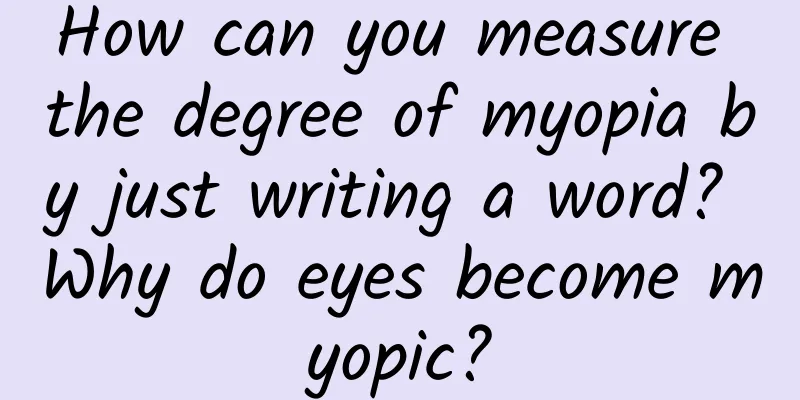How can you measure the degree of myopia by just writing a word? Why do eyes become myopic?

|
Are you nearsighted? Do you know how nearsighted you are? In fact, it is very simple to know the degree of myopia. Just write a word on a piece of paper, and then put the paper in front of you where you can see clearly. Then slowly move the paper away. When the words on the paper are slightly blurred and rough edges appear, stop, and then measure the distance between the paper and your eyes. Finally, you only need to divide 100 by the measured number to get the degree of myopia. If the distance we measured is 0.5 meters, then the degree of myopia is 200 degrees. Now you can try to see if the final measured degree is consistent with your myopia degree. If the measurement result is correct, let's talk about the principle of this measurement method. If it is incorrect, then measure it again until it is correct. To understand the inner principle of this measurement method, we must first understand why the eye is myopic. The eye is an extremely delicate organ, but from a physical point of view, it can also be very simple. In fact, the eye can see things based on the same principle as the image formation of a convex lens. We know that when the light emitted by an object passes through a convex lens, it will produce a convergence effect, and finally the light will converge to a point at a certain position behind the convex lens. This point is called the focus, and the light will form an inverted real image behind the convex lens. There are three main physical quantities in the convex lens imaging experiment. The first is the distance between the object and the convex lens, which is called the "object distance". The second is the distance between the convex lens and the image formed on the screen behind it, which is called the "image distance". The third is the distance between the convex lens and the focus, which is called the "focal length". There is a close relationship between these three physical quantities, which can be expressed as 1/u+1/v=1/f, where u represents the object distance, v represents the image distance, and f represents the focal length. Our eyes are actually a convex lens system, and in front of the eyeball is the lens, which is a convex lens. When the light emitted by an object passes through the lens, it converges and eventually forms an image on the retina behind the eyeball, so we can see the object. But there is a problem here, that is, the size of the eyeball is basically fixed, that is, the distance from the lens to the retina is fixed, or in other words, the object distance is fixed. However, what the eyes see is near and far, that is, the object distance is constantly changing. The object distance is constantly changing, while the image distance remains unchanged. In this case, in order to see things clearly, the focus must be adjusted, and the eyes happen to have this ability. There is a muscle on both sides of the lens, called the ciliary muscle, which can control the focal length of the lens by contracting and relaxing. When we look at something far away, the ciliary muscle relaxes, so the lens becomes flat and the focal length increases. When we look at something close, the ciliary muscle tightens, so the lens becomes convex and the focal length decreases. If we do not pay attention to eye hygiene and read or write too close for a long time, the ciliary muscle will continue to be tense. Over time, the ciliary muscle will be locked and unable to relax, so there is no way to enlarge the focal length, and naturally we cannot see things far away clearly, and our eyes become myopic. Now that we understand why eyes become myopic, we can go back to the principle of measuring myopia by writing. The inability of the ciliary muscle to relax freely limits the length of the object distance. Since the degree of myopia varies from person to person, the limit of the object distance is also different. The above method can be used to measure the limit of the object distance. The reciprocal of the object distance is the diopter, and the degree of myopia is 100 times the diopter. For example, if the object distance is 0.5 meters, the diopter is 1/0.5, and the degree is 200 degrees. Glasses are concave lenses, which can form an upright virtual image in front of the lens, which is equivalent to bringing distant objects closer. If the maximum object distance that a myopic person can see clearly is 0.5 meters, then he only needs to wear a pair of 200-degree glasses to form a virtual image of the distant object 0.5 meters in front, and he can naturally see it clearly. For more information, please follow the official account: sunmonarch |
>>: What kind of meat is in the beef balls that cost 9.9 yuan per pound?
Recommend
Can "Yang Kang" take off the mask? What is the situation of repeated fever? Expert interpretation of the new crown hot spots, understand it in one picture!
If you have questions about the coronavirus Espec...
Bilibili product analysis: Station B’s path to change
The multiple historical highs created by Bilibili...
TSMC will launch 12nm process, leaving GlobalFoundries in the dust
At the beginning of this year, the poor yield rat...
World Day to Combat Desertification and Drought丨Greening and sand retreating! See the green territory continue to expand
Desertification is a major global ecological prob...
A brief analysis of the three principles and four strategies for community content operations
A good community will inevitably form a stable cl...
President Xi Jinping delivers 2024 New Year message
On the eve of the New Year, President Xi Jinping ...
Wait a little longer, the domestically produced Tesla Model 3, which is priced at 320,000 yuan, still has a huge room for price reduction
Finally, Tesla announced the price of the Model 3...
iOS 16.4 official version is released, it is recommended to upgrade!
Early this morning, Apple pushed the official ver...
What Sony didn't tell you about HDR
Although there are still more than four months le...
Did the “earthquake cloud” predict the Texas earthquake? Here comes the August science rumor list →
1. "Earthquake Cloud" predicted the ear...
Vegetables and fruits, which one has a higher vitamin C content? The truth is heartbreaking!
gossip: The vitamin C content of fruits is higher...
As the college entrance examination approaches, a big competition of brain-boosting foods! Walnuts are at the bottom of the list? You would never have thought that the first one would be
The college entrance examination is coming soon, ...
Which industries are suitable for bidding for OCPC? Urgent, waiting online!
We all know that Baidu recently updated its backe...
An unspeakable question: Why does my poop always float?
After releasing yourself in the bathroom, do you ...
The Force Awakens: Sunflower Remote Control IOS5.0 New Touch Button Tribute to Star Wars
[[161803]] After a lapse of ten years, Star Wars:...









